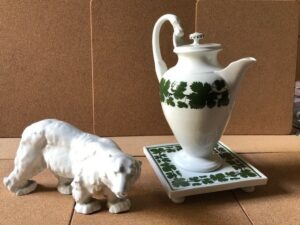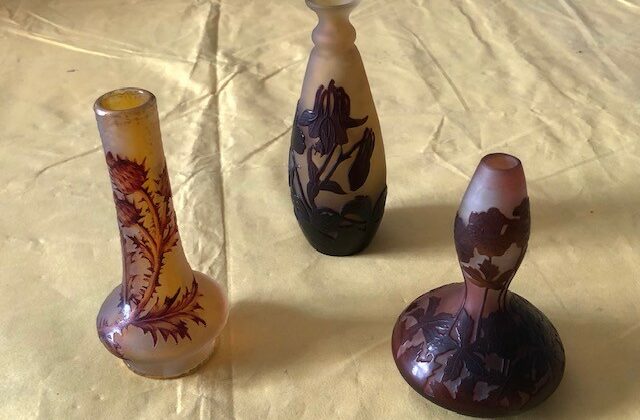Meissen, the porcelain master mark
Prof. Francesco Carelli

Photo: unusual animal figure in Meissen’s catalogue, showing a polar bear. Teapot with swan as handle, series decoration with grape leaves. Square teapot rest.
Meissen porcelain or Meissen china was the first European hard-paste porcelain. Early experiments were done in 1708 by Ehrenfried Walther von Tschirnhaus. After his death that October, Johann Friedrich Böttger continued von Tschirnhaus’s work and brought this type of porcelain to the market, financed by Augustus the Strong, King of Poland and Elector of Saxony. The production of porcelain in the royal factory at Meissen, near Dresden, started in 1710 and attracted artists and artisans to establish, arguably, the most famous porcelain manufacturer known throughout the world. Its signature logo, the crossed swords, was introduced in 1720 to protect its production; the mark of the swords is reportedly one of the oldest trademarks in existence.
Meissen remained the dominant European porcelain factory, and the leader of stylistic innovation, until somewhat overtaken by the new styles introduced by the French Sèvres factory in the 1760s, but has remained a leading factory to the present day. Among the developments pioneered by Meissen are the porcelain figurines, and the introduction of European decorative styles to replace the imitation of Asian decoration of its earliest wares.
The Albrechtsburg was utilized to protect the secrets of the manufacture of the white gold. As a further precaution, very few workers knew the arcanum (hidden, secret knowledge) of how to make porcelain, and then perhaps only part of the process. Thus, for a few years, Meissen retained its monopoly on the production of hard-paste porcelain in Europe. By 1717, however, a competing production was set up at Vienna, as Samuel Stöltzel, head of the craftsmen and arcanist at Meissen, sold the secret recipe, which involved the use of kaolin, also known as china clay. By 1760 about thirty porcelain manufacturers were operating in Europe, most of them, however, producing frit based soft-paste porcelain.
In order to identify the original Meissen products, Meissen developed markings that initially were painted on, but were soon fired in underglaze blue. Early markings such as AR (Augustus Rex, the monogram of the King), K.P.M. (Königliche Porzellan-Manufaktur), M.P.M. (Meissener Porzellan-Manufaktur), and K.P.F. (Königliche Porzellan-Fabrik) were eventually replaced by the crossed swords logo, based on the arms of the Elector of Saxony as Arch-Marshal of the Holy Roman Empire. Variations in the logo allow approximate dating of the wares.
Under Erich Hösel, who became head of the modelling department in 1903, old styles were revived and reinterpreted. Hösel also restored eighteenth century models. Some appealing work in the Art Nouveau style was produced, but Meissen’s mainstay continued to be the constant production of revived eighteenth-century models.
Johann Joachim Kändler modelled many of the most famous figures, which were initially made for decorating the tables at grand meals, usually in white, replacing sugar sculptures. However, they soon became very popular as ornaments for living rooms and were cheaper than an entire table service, so available to a rather wider market, both in terms of geography and social class. Kändler soon had them brightly painted, increasing their attraction.
Human figures were mostly courtiers, shepherds and shepherdesses (Dresden shepherdess is a proverbial term), commedia dell’arte characters, animals, personifications or “allegorical figures” (such the seasons, virtues, or continents) and figures in Chinese and Turkish costumes. As well as the pastoral fantasy shepherdesses there were also some more realistic figures of urban workers, based on print series of the street cries of Paris, London and other cities. In the 1750s a large series of miners was produced.
After World War II, most of the equipment was sent to the Soviet Union as part of war reparations. However, the workers using traditional methods and the kilns that had not been dismantled were able to resume production by 1946. The company became a Soviet Joint Stock Company in Germany. Almost all of the production was sent to the Soviet Union, a crucial step that kept the artisan community alive. After the establishment of the German Democratic Republic, the company was handed over to German ownership in 1950 and became a Volkseigener Betrieb (VEB), a “people-owned company”. VEB Meissen Porzellan turned out to be one of the few profitable companies in the economically troubled East German system, earning much needed foreign currency. After the German reunification, since 1991 the manufactory has been operating as the Staatliche Porzellan-Manufaktur Meissen GmbH, whose owner is the Free State of Saxony. The company is one of the world’s leading porcelain manufacturers and one of the oldest and most internationally known German luxury brands. While its products are expensive, the high quality and artistic value make Meissen porcelain desirable by collectors and connoisseurs.



